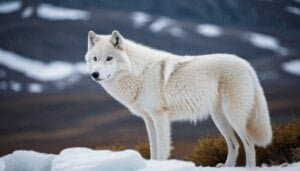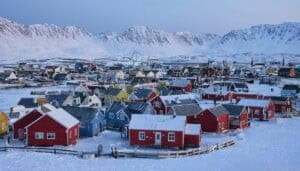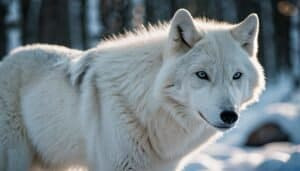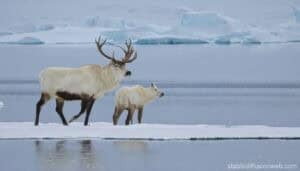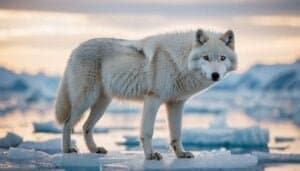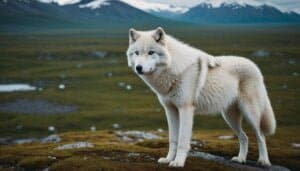Introduction
Understanding how Arctic wolves are perceived in the context of Arctic community building requires exploring multiple facets of their relationship with local residents
This article delves into the historical connections and cultural significance of Arctic wolves, their influence on daily life, and the spiritual and ecological roles they play. We’ll examine how these majestic creatures impact hunting practices and community activities, alongside the beliefs and traditions they inspire
Additionally, the balance between wolf conservation and community needs will be discussed, highlighting the challenges and opportunities that come with coexisting with Arctic wolves. Finally, we will explore the future outlook and strategies for managing these intricate relationships
Historical Relationship Between Arctic Wolves and Arctic Communities
The relationship between Arctic wolves and Arctic communities is deeply intertwined, shaped by centuries of coexistence in one of the harshest environments on Earth. These wolves, known for their resilience and adaptability, have not only survived but thrived alongside human populations in the Arctic
This section explores the cultural significance, historical interactions, and evolving perceptions of Arctic wolves within these communities
Cultural Significance of Arctic Wolves
Arctic wolves hold a special place in the cultural fabric of many Arctic communities. Often depicted in local folklore and mythology, these wolves are seen as symbols of strength, endurance, and survival. Indigenous groups, such as the Inuit, have numerous stories that feature Arctic wolves, reflecting their deep respect and reverence for these animals
In some legends, Arctic wolves are portrayed as spiritual guides, helping humans navigate the treacherous Arctic landscape. These narratives not only highlight the wolves’ importance but also the lessons they impart about resilience and adaptability, essential traits for survival in the Arctic
Historical Interactions and Coexistence
Historically, Arctic wolves and human communities have shared the same spaces, often leading to interactions that range from cautious coexistence to direct conflict. For centuries, Arctic wolves have followed the migrations of caribou, a primary food source also crucial to the survival of many Arctic peoples
This shared dependency on caribou has historically positioned wolves and humans as both competitors and mutual participants in the Arctic ecosystem
Archaeological evidence suggests that early Arctic inhabitants learned from wolves, adopting similar hunting strategies and social structures. For instance, both wolves and humans form close-knit social groups that hunt cooperatively, ensuring better chances of survival
Additionally, the scavenging habits of wolves have historically benefited human communities by leading them to potential food sources during scarce periods
Changes in Perception Over Time
Over time, the perception of Arctic wolves in these communities has evolved, influenced by changing environmental conditions, cultural shifts, and modern conservation efforts
In the past, the presence of wolves was primarily seen through a lens of competition, particularly concerning hunting territories and food sources. As human populations expanded and technology advanced, the necessity to view wolves as direct competitors diminished, giving way to a more nuanced understanding of their ecological role
In contemporary times, with increased awareness of ecological balance and biodiversity, many Arctic communities now recognize the importance of wolves in maintaining the health of the ecosystem
This shift is partly due to educational initiatives and scientific research highlighting the role of predators in controlling herbivore populations and promoting vegetation growth. Studies, such as those conducted by the Wildlife Conservation Society, emphasize that predators like the Arctic wolf play a critical role in ecosystem dynamics (Wildlife Conservation Society, 2020)
This evolving perception is also reflected in the laws and regulations aimed at protecting Arctic wolves. For instance, the establishment of protected areas and wildlife reserves has helped mitigate human-wolf conflicts and promote coexistence. Programs that encourage sustainable hunting practices and respect for wildlife have also contributed to a more harmonious relationship between Arctic wolves and human communities
The Role of Arctic Wolves in Daily Life
Arctic wolves play a significant role in the daily lives of Arctic communities, influencing various aspects from subsistence practices to cultural education. This section examines their impact on hunting practices, community activities, and educational aspects for children
Impact on Hunting Practices
In Arctic communities, hunting is a crucial part of life, providing essential resources such as food, clothing, and tools
Arctic wolves, as apex predators, directly impact the availability of prey species, thereby influencing hunting strategies and outcomes for human hunters. The presence of wolves can both complicate and aid human hunting efforts
When wolves hunt caribou or other prey, they often leave behind remains that can be utilized by human hunters. This scavenging opportunity can be vital, especially during times when hunting is less successful. However, wolves also compete for the same prey, which can reduce the availability of game for humans. Hunters must be keenly aware of wolf packs’ movements and hunting patterns to avoid conflicts and maximize their own success
Moreover, the hunting techniques of Arctic wolves have been observed and emulated by human hunters. Wolves exhibit remarkable teamwork, patience, and endurance during hunts, qualities that are also prized in human hunting traditions. By understanding and mimicking wolf hunting strategies, Arctic hunters can improve their effectiveness and efficiency
Influence on Community Activities
Arctic wolves’ influence extends beyond hunting to various community activities. Their presence and behaviors can dictate the movement and settlement patterns of human communities. For instance, areas frequented by wolves might be avoided for safety reasons or chosen as settlements due to the availability of prey attracted by wolf presence
Wolves also play a part in traditional practices and ceremonies. In some Arctic cultures, the sighting of a wolf or the sound of its howl can be seen as an omen or a message from the spiritual world. These encounters can prompt community gatherings and rituals, reinforcing social bonds and cultural heritage
Additionally, the wolves’ behavior and movements are closely monitored by community members, providing valuable information about the environment. Changes in wolf pack behavior can indicate shifts in prey populations or environmental conditions, helping communities make informed decisions about their own activities and movements
Educational Aspects for Children
In Arctic communities, education about the natural world is a critical component of child-rearing, and Arctic wolves feature prominently in this informal curriculum. Children are taught to respect wolves and understand their role in the ecosystem from a young age. This education includes lessons on wolf behavior, hunting techniques, and the importance of coexistence
Storytelling is a primary method for passing down knowledge about Arctic wolves
Elders share stories that highlight the wisdom and skills of wolves, teaching children about survival, cooperation, and the balance of nature. These stories are not only entertaining but also instill important values and knowledge that help young community members navigate their environment
Practical education also involves observing wolves and learning to track their movements. Children accompany adults on hunting trips and other excursions, where they learn to identify wolf tracks, understand their calls, and interpret their behaviors. This hands-on learning fosters a deep connection with nature and an appreciation for the role of wolves in the Arctic ecosystem
Programs and initiatives aimed at preserving Arctic wolf populations often include educational components that engage children. For example, the Arctic Wolf Conservation Project works with local schools to provide educational materials and organize field trips, fostering a sense of stewardship and responsibility towards wildlife conservation among the younger generation (Arctic Wolf Conservation Project, 2022)
Spiritual and Cultural Beliefs About Arctic Wolves
Arctic wolves hold a profound place in the spiritual and cultural beliefs of many Arctic communities. This section delves into the mythology and folklore surrounding these animals, their role in rituals and traditions, and their spiritual symbolism
Mythology and Folklore
Arctic wolves are central figures in the mythology and folklore of Arctic indigenous cultures
Stories passed down through generations often feature wolves as wise and powerful beings. For example, in Inuit mythology, the wolf is often depicted as a creator and a guide. One popular legend tells of a giant wolf that created the land by running across the sky, its footsteps forming the mountains and valleys
These stories serve multiple purposes. They explain natural phenomena, teach moral lessons, and reinforce cultural values. The wolf’s characteristics, such as its hunting prowess, loyalty to its pack, and survival skills, are qualities admired and emulated by community members. By telling these stories, elders impart important cultural knowledge and life lessons to younger generations
Rituals and Traditions
Arctic wolves also play a significant role in various rituals and traditions. Many Arctic communities have ceremonies that honor the wolf, often linked to hunting and survival. For instance, some Inuit tribes perform rituals before and after hunting to show respect for the animals they hunt, including wolves. These rituals may involve offering parts of the hunt to the wolves, believing that such acts will ensure successful hunts in the future
In other traditions, the howling of a wolf is seen as a call to the spiritual world. Shamans and spiritual leaders may interpret wolf howls as messages from ancestors or spirits, guiding the community’s actions and decisions. These interpretations can influence everything from hunting strategies to the timing of community events
The presence of wolves in the environment is often considered a good omen, signaling a healthy ecosystem and abundant resources. This belief reinforces the community’s connection to the natural world and their dependence on its balance
Spiritual Symbolism
In many Arctic cultures, the wolf symbolizes various spiritual qualities. It is often seen as a guardian and a teacher, embodying wisdom, strength, and resilience. Wolves are admired for their social structures and cooperative hunting strategies, which mirror the values of community and teamwork that are crucial for survival in the Arctic
The spiritual symbolism of wolves is also evident in art and personal adornments. Many Arctic peoples create carvings, masks, and other artworks that depict wolves, often integrating them into ceremonial objects and attire. These representations serve as reminders of the wolf’s spiritual significance and the traits it embodies
Personal totems and amulets featuring wolves are commonly worn for protection and guidance. Hunters might carry a wolf talisman to invoke the animal’s hunting prowess, while others might use wolf imagery in tattoos or jewelry to signify their connection to the wolf’s spirit
In recent years, efforts to document and preserve these spiritual beliefs have increased. Projects like the Arctic Indigenous Spirituality Initiative aim to record traditional stories and practices related to Arctic wolves, ensuring that this rich cultural heritage is not lost amid modernization and environmental changes (Arctic Indigenous Spirituality Initiative, 2021)
Arctic Wolves and Ecosystem Impact
Arctic wolves play a critical role in maintaining the ecological balance of the Arctic region. This section examines their ecological role, the balance between wolf conservation and community needs, and the conservation efforts and challenges faced by Arctic communities
Ecological Role of Arctic Wolves
Arctic wolves, as apex predators, are essential for maintaining the health of their ecosystem. By preying on herbivores such as caribou and muskoxen, they help regulate these populations, preventing overgrazing and promoting vegetation growth. This balance is crucial in the fragile Arctic environment, where plant life is sparse and slow-growing due to extreme conditions
Research has shown that the presence of wolves leads to healthier, more diverse ecosystems. Wolves help control the population of primary consumers, which in turn supports a wider variety of plant species
This cascading effect, known as a trophic cascade, demonstrates the interconnectedness of Arctic wildlife. A study by the Wildlife Conservation Society highlighted that areas with active wolf populations exhibit more robust plant growth and greater biodiversity (Wildlife Conservation Society, 2020)
Wolves also play a role in disease control. By preying on sick or weak animals, they help reduce the spread of diseases within herbivore populations. This natural form of disease management is vital for the overall health of Arctic wildlife
Balance Between Conservation and Community Needs
Balancing the conservation of Arctic wolves with the needs of local communities can be challenging. Wolves are sometimes seen as threats to livestock and game, leading to conflicts with human interests. However, the ecological benefits they provide necessitate their protection
Conservation efforts often involve creating protected areas where wolves can thrive without human interference. These protected zones are crucial for the survival of wolf populations but can sometimes restrict human activities like hunting and development. Effective conservation strategies must address both ecological and community needs, finding solutions that allow for coexistence
One successful approach has been the implementation of community-based conservation programs. These initiatives involve local residents in conservation efforts, ensuring that their knowledge and needs are considered
For example, the Nunavut Land Claims Agreement includes provisions for the protection of wildlife while respecting traditional hunting practices. This agreement allows for sustainable hunting, ensuring that both wolves and human communities can coexist (Nunavut Land Claims Agreement, 1993)
Conservation Efforts and Challenges
Conservation efforts for Arctic wolves face numerous challenges, including climate change, habitat loss, and human-wolf conflicts. As the Arctic warms, the habitat of wolves and their prey is rapidly changing, threatening their survival. Melting ice and thawing permafrost alter the landscape, affecting the availability of food and shelter for both wolves and their prey
Human activities, such as mining and oil exploration, also contribute to habitat loss. These activities can fragment wolf territories, making it difficult for them to find sufficient food and mate. Protecting critical habitats from industrial development is essential for the conservation of Arctic wolves
Another significant challenge is the potential for human-wolf conflicts. As wolves venture closer to human settlements in search of food, they may prey on livestock, leading to tensions with local farmers and herders. Implementing non-lethal deterrents, such as electric fences and guard animals, can help reduce these conflicts and promote coexistence
Several organizations are dedicated to the conservation of Arctic wolves. The World Wildlife Fund (WWF) works to protect critical habitats and promote sustainable practices that benefit both wolves and local communities. Their initiatives include habitat restoration projects and community education programs that emphasize the importance of wolf conservation (WWF, 2021)
Challenges and Opportunities in Coexisting with Arctic Wolves
The coexistence of Arctic wolves and human communities presents unique challenges and opportunities. This section explores the management of wolf-human conflicts, the benefits of coexistence, and future outlooks and strategies for harmonious living
Managing Wolf-Human Conflicts
One of the primary challenges in Arctic regions is managing conflicts between wolves and humans. These conflicts often arise from wolves preying on livestock or game animals, which are crucial for the subsistence of local communities. Effective management strategies are essential to mitigate these conflicts and promote peaceful coexistence
Non-lethal deterrents have proven effective in reducing wolf predation on livestock. Measures such as electric fences, guard dogs, and motion-activated lights can protect livestock without harming wolves. For instance, in parts of Canada, the use of livestock guardian dogs has significantly decreased wolf attacks on livestock, demonstrating a practical approach to conflict management (Canadian Agricultural Partnership, 2021)
Community engagement and education are also vital. Informing residents about wolf behavior and the ecological benefits of wolves can foster greater tolerance and understanding
Workshops and community meetings provide platforms for discussing concerns and developing collaborative solutions. The International Wolf Center, for example, offers educational programs that teach communities how to coexist with wolves and implement effective non-lethal management strategies (International Wolf Center, 2022)
Benefits of Coexistence
Despite the challenges, there are numerous benefits to coexisting with Arctic wolves. Wolves play a crucial role in maintaining the health and balance of the ecosystem, which ultimately benefits human communities
By controlling herbivore populations, wolves help prevent overgrazing and promote the growth of vegetation. This ecological balance supports a more diverse and resilient environment, which can enhance the availability of resources for human communities
Furthermore, wolves contribute to the cultural and spiritual richness of Arctic communities. Their presence in the environment and in cultural narratives reinforces a deep connection to nature and heritage. This connection can strengthen community bonds and foster a sense of identity and continuity
Tourism also presents an economic opportunity linked to wolf conservation. Wildlife enthusiasts and researchers are drawn to regions where wolves thrive, bringing economic benefits to local communities through eco-tourism
Properly managed, this can provide a sustainable source of income while promoting conservation efforts. The Yukon Wildlife Preserve in Canada is an example where eco-tourism centered around wildlife, including wolves, supports both conservation and local economies (Yukon Wildlife Preserve, 2020)
Future Outlook and Strategies
Looking to the future, strategies for coexisting with Arctic wolves must focus on adaptability and resilience. Climate change continues to alter the Arctic landscape, affecting both human and wolf populations. Adaptive management strategies that account for changing conditions are crucial
One approach is the development of dynamic conservation plans that can be adjusted based on ongoing monitoring and research. These plans should incorporate traditional ecological knowledge from indigenous communities, which offers valuable insights into the natural behaviors and needs of wolves. Collaborative research projects that involve both scientists and local residents can enhance understanding and inform effective conservation practices
Legislative support and policy development are also critical. Policies that protect critical habitats, regulate hunting, and promote sustainable practices can create a framework for long-term coexistence. The Arctic Council, an intergovernmental forum, plays a key role in coordinating conservation efforts across Arctic nations and addressing transboundary issues related to wildlife conservation (Arctic Council, 2019)
Innovative technologies can aid in monitoring wolf populations and managing human-wolf interactions. Satellite tracking and remote sensing provide data on wolf movements and habitat use, enabling more precise and informed management decisions. These technologies can help identify potential conflict zones and implement preventive measures
Conclusion
The relationship between Arctic wolves and Arctic communities is a multifaceted and evolving dynamic that highlights the importance of ecological balance and cultural heritage
Historically, Arctic wolves have been integral to the cultural fabric and daily survival of Arctic peoples, influencing hunting practices and community activities. Their presence in mythology, rituals, and spiritual beliefs underscores their significance beyond mere survival
Ecologically, Arctic wolves play a crucial role in maintaining the health of the Arctic ecosystem, controlling herbivore populations, and promoting biodiversity. Conservation efforts and challenges highlight the need for a balanced approach that respects both ecological integrity and community needs. By managing human-wolf conflicts through non-lethal deterrents and fostering community education, harmonious coexistence becomes achievable
The benefits of coexisting with Arctic wolves are profound, offering ecological, cultural, and economic advantages. Future strategies must be adaptive, incorporating traditional knowledge, innovative technologies, and supportive policies to address the challenges posed by climate change and habitat loss
By embracing these approaches, Arctic communities and Arctic wolves can continue to thrive together, preserving the rich cultural heritage and ecological balance of this unique region




